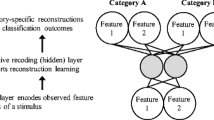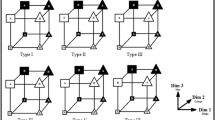Abstract
Two experiments investigated binary categorization of artificial, multidimensional objects that were presented for intervals between 33 and 200 ms. The experiments consisted of two stages. In the first stage, participants learned to categorize nine objects into two categories. In the second stage, the same objects were presented for categorization again, and the presentation duration of the objects was manipulated. The results show systematic effects of exposure duration on category choices. Three formal process models of perceptual categorization were applied to the choice data. The extended generalized context model, which is a dimension-sampling model of perceptual categorization, provided the best account of the data.
Similar content being viewed by others
Author information
Authors and Affiliations
Additional information
Received: 31 October 1997 / Accepted: 1 June 1998
Rights and permissions
About this article
Cite this article
Lamberts, K., Freeman, R. Categorization of briefly presented objects. Psychological Research Psychologische Forschung 62, 107–117 (1999). https://doi.org/10.1007/s004260050045
Issue Date:
DOI: https://doi.org/10.1007/s004260050045




